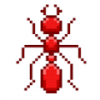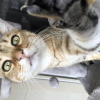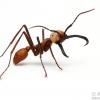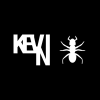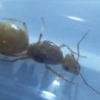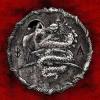I hope to offer this to U.S. customers soon, as a highly experimental protein substitute.
Editor's note: "Whole Insect Protein Extract," or WIPE, describes the composition of the food. The product will have a different trade name/pseudonym when it becomes available for sale. Update: The product will be called "byFormica Blue."
Overview:
byFormica Blue is 100% derived from live, whole insects that have been made into liquified form, and has the consistency of ketchup or mustard. The ants first drink all the available liquid, which consists of water and insect fats, after which a solid paste remains on the feeding dish, mostly protein. The ants then collect these solid particles for storage or immediate feeding to larvae.
WIPE Composition and Critique:
Except for an evaporating preservative agent, no sugar or other ingredients are added.
In contrast, ants generally are not attracted to, and will not consume standalone protein from whey or casein (both milk products), which is traditionally incorporated in all-in-one meridic ant diets. This critical difference in receptivity, along with scientific journals unable to replicate positive outcomes for synthetic diets containing whey or casein proteins, ultimately lead me to the conclusion that such denatured, bovine-derived proteins are unrecognizable to ants, and likely have no nutritive value on account of being poorly absorbed, if they are able to be assimilated or broken down at all.
WIPE Storage:
Currently, the WIPE mixture must remain at or below 0 C for extended periods, but it should resist 2-3 days in shipping at room temperature. The pilot test batch has been stored at or below freezing temperatures for over 15 months, as of this writing, with no apparent change in quality.
The preservative agent keeps the mixture from freezing solid, and evaporates completely after a few minutes once dispensed in small amounts. It is important to note that prior to evaporation, the preservative acts as a deterrent, so ants will be repelled from the food until the preservative evaporates out.
WIPE Benefits:
Over 90% of the insoluble particles (such as chitin) have been mechanically removed from the solution. Consequently, one obvious benefit from this potential food, is that no or negligible waste or frass is produced when using this insect extract, aside from uneaten amounts left on the feeding dish, if any. Particles that are too small to be removed during manufacturing are generally lumped together with the protein particles for storage and consumption by larvae.
I have experienced positive receptivity across a few different omnivorous species. I hope to get a good amount of feedback regarding receptivity and efficacy from users who purchase the experimental product, before investing more time in processes to improve the usability and hopefully eliminate the cold storage requirement.
1st video notes: Off camera, the ants in the video eventually consumed or otherwise stored 100% of the food, including all residue, from the feeding dish, similar to the behavior observed at the end of the second video, below.
The ants will sometimes appear to attack or chew the liquid as in 2:32 of the Camponotus video, which is typical behavior towards protein foods, regardless of whether it is a solid or liquid state.
2nd video notes: The video was recorded over a 30-minute period, and splits at the 1:30 mark to show the beginning and end in a condensed 3-minute clip.
Oct 17 Update:
byFormica is very close to a commercial release of the first-ever insect-based food for ants, byFormica Blue.
The main ingredients are whole, live insects — Waxworm moth larvae, mixed soldier fly larvae and pupae, mixed surinam cockroach nymphs and adults, silkworm moth larvae, and subterranean termites make up the largest proportion of ingredients, by far. Additional ingredients are added only to naturally preserve the product, and to make the food easily visible when ingested or stored.
We separate the meat from the bones — A raw, no heat process separates the indigestible skins and exoskeletons from the liquid and meat contained in the insect. At no stage are the insects cooked, heated, dried, or substantially altered. We then recycle the skins and exoskeletons by feeding them back to other insects capable of consuming them, before processing those insects in a later stage. We achieve a precise 70% moisture content for the final product, with the other 30% being pure proteins and lipids. The result is a food that your ants can consume fully, with virtually no waste or garbage.
Enhanced nutrition compared to commercial feeders — Commercially bred insects are notoriously deficient in phytonutrients compared to their wild counterparts. For this reason, we add some carefully selected wild insects to byFormica Blue, and also feed some of our stock an enriched diet that balances and restores the final nutritional profile of our food to that which is similar to wild insects, and beyond that of which commercially raised feeders alone are capable. Use as a supplement, or as a replacement, to highly perishable feeder insects.
Goodness concentrated in each bottle — Due to our novel manufacturing process and bug selection, each 15 ml bottle contains the nutritional equivalent of about 130 insects, with an average weight of over 150 mg per insect before processing.
Precisely control colony growth — Each bottle contains about 500 drops of liquid, which are easily served on provided plastic serving trays, up to 6 drops per tray. The growth of a large colony may be easily adjusted by feeding more or fewer drops, or with greater or lesser frequency. Along with an ad libitum amount of Sunburst Ant Nectar, a single 15 ml bottle of byFormica Blue provides enough food to rear hundreds of larger ants, or thousands of smaller ants.
Served liquid stays fresher, longer — When used as directed, the liquid product stays fresh on the feeding tray for weeks after drying, with minimal loss in quality. A drop of water may be added to dried product, to increase its attractiveness. Compare that to commercial feeders, which may turn black and rot if not eaten quickly.
Edited by drtrmiller, October 17 2016 - 5:08 AM.





